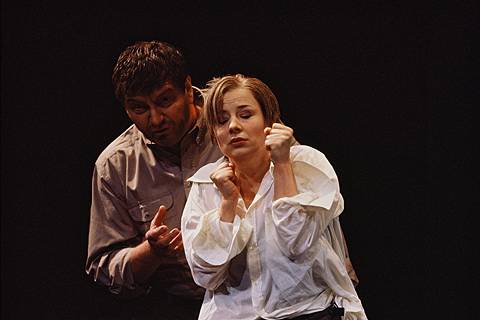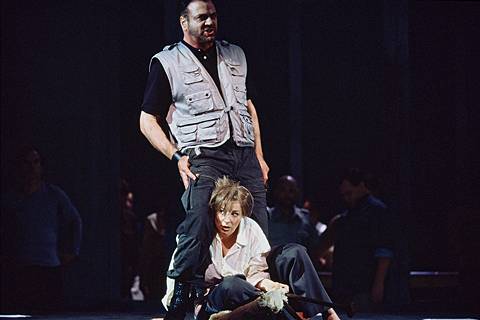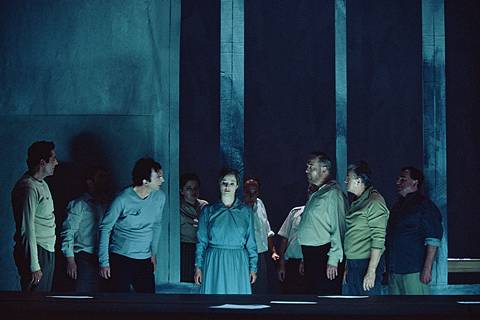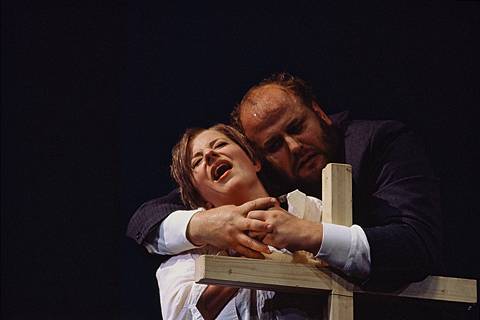|
<< -- 3 -- Roderic Dunnett AN OPERA OF EXTREMES

The opera divides more or less into three scenes ; Simplicius first encounters the Bauer (Peasant-farmer), a rebuking but kindly employer who chaffs him as a 'Eselkopp' (Ass's head) but instructs him in the ways of the human and animal world.

Helmut Berger-Tuna (Bauer) and Claudia Mahnke (Simplicius). Photo © 2004 A T Schaefer, Stuttgart
|
There is a horrific interlude -- terrific brass, clarinets, bassoons, percussion working overtime under the first rate direction of Kwamé Ryan, a perceptive and capable young Canadian-Trinidadian conductor given encouragement by Stuttgart's Music Director Lothar Zagrosek.

Michael Ebbeke (Landsknecht) and Claudia Mahnke (Simplicius). Photo © 2004 A T Schaefer, Stuttgart
|
Into this world of work, part rural idyll, part the irksome, hard drudgery of survival, explodes the horrifying Landsknecht, the brutal upstart of the mounted Blitzkrieg and jackbooted Press Gang, whose appalling ditties -- a kind of ugly parody of Simplicius's own lilting ones, in grim mock-verse -- unleash the vicious destruction of the peaceful landscape. It must have been very much like this when the Swedes and their allies laid waste Germany as far as Prague. The production was enhanced here not just by vocally impressive and forceful performances from Helmut Berger-Tuna (Bauer) and Michael Ebbecke (Landsknecht), but by the fine Stuttgart chorus, who excelled in the curious kind of 'Sprechchor' which Hartmann employs here.

The effective Stuttgart Opernchor. Photo © 2004 A T Schaefer, Stuttgart
|
The Second Part, Scene or Tableau is in several senses the opera's heart. Here Simplicius meets a Hermit (Einsiedel), a simplehearted wise man whom we first encounter invoking the Nightingale and the world of the birds who accompany his solitude into hymning the Deity : 'Lass dein Stimmlein laut erschallen / dann vor allen kannst du loben / Gott in Himmel hoch dort oben.'

Claudia Mahnke (Simplicius) with Frank von Aken (Hermit). Photo © 2004 A T Schaefer, Stuttgart
|
It's this Franciscan-like hymn which gives Hartmann the justification for interweaving with his music (paradoxically) an underlay of Lutheran hymnology ('The glorious day now closeth' is prominent), which is largely responsible for the impact of the whole opera. Simplicius's own optimism (epitomised by the way he took up the Bauer's great song in the first scene) is underlain by similar qualities. Rather as in Pfitzner's Palestrina, or Hindemith's Mathis der Maler, we sense the power of the church underpinned by sacred music itself, so here in Simplicius Simplicissimus the music exposes the enduring power of good against the constant onslaught of unmitigated, unleashed evil. It's an opera of extremes : amid rural harmony, when Hartmann writes his instrumental scherzi here, he outdoes even Kurt Weill's ability to depict the savage, the depraved and the irredeemable.
Stuttgart cast the Dutch tenor Frank von Aken as the Hermit. This was a wonderful performance, sensitive, sympathetic, wise. The interaction between Mahnke and von Aken provided a core to the opera's -- and Grimmelshausen's -- message. There is a future, there is hope, there is learning and instruction : the old ways and the old certainties do, in strange and unpredictable ways, survive.
Continue >>
Copyright © 6 June 2004
Roderic Dunnett, Shropshire UK

|

